From the archives: The Italian approach to a world champion rally car.
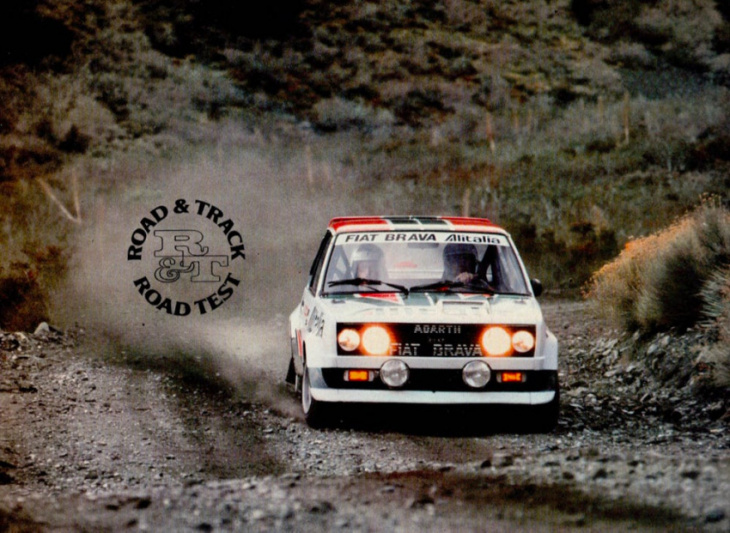
When Fiat decided it needed a new rally car to replace the aging 124 Abarth Spider, it looked at a 2-liter edition of the X1/9. but finally settled on a competition version of the 131 sedan, now known in the U.S. as the Brava. In most every other form of motorsport you wouldn’t be opting for a sedan over a 2-place sports car in an attempt to win overall in the same class of competition, but that’s the way rallying is. Look over the entry list of a major international rally and you may find big 4.5-liter V-8 Mercedes-Benz 450 SLCs, 3-liter Porsche 911s, turbocharged Saab 900s, mid-engine Lancia Stratos, 2-liter Ford Escorts and Fiat Abarth 131s, all possible leaders. It’s simply a question of horses for courses, and as an example, the impressive horsepower but high weight of the Mercedes can be as much an asset in one event as a handicap in another. In the 1980 Monte Carlo Rally, foul conditions with plenty of snow, fog and rain favored the competitors with less horsepower and/or front-wheel drive. Each rally machine has its equivalent set of vices and virtues.
Rally cars are generally built and developed to succeed in rallies in their home markets, or in events picked for their prestige (which means sales), or to display the car’s best features. This explains why Ford Escorts are quick in the forests of England; Fiats often win Italian rallies which have more pavement and higher speeds; Saab’s best showing in 1979 was a victory in the Swedish Rally; Peugeots make their point in that firm’s critical sales area of Africa; and why Mercedes will only attempt (at this point) rallies to which their cars are eminently suited. That’s not to say any car has an exclusive in any territory, owing to the very complex nature of rallying. Grand Prix teams really deal with a set of absolutes compared to rally teams, which need not only a good car. but also a much larger organization. The rallyists require several crews of good mechanics, at least as much testing and training as a GP effort and yet have to worry about all the vagaries of weather and dirt roads … to say nothing of that old motorsports factor, luck.
This story originally appeared in the May 1980 issue of Road & Track.
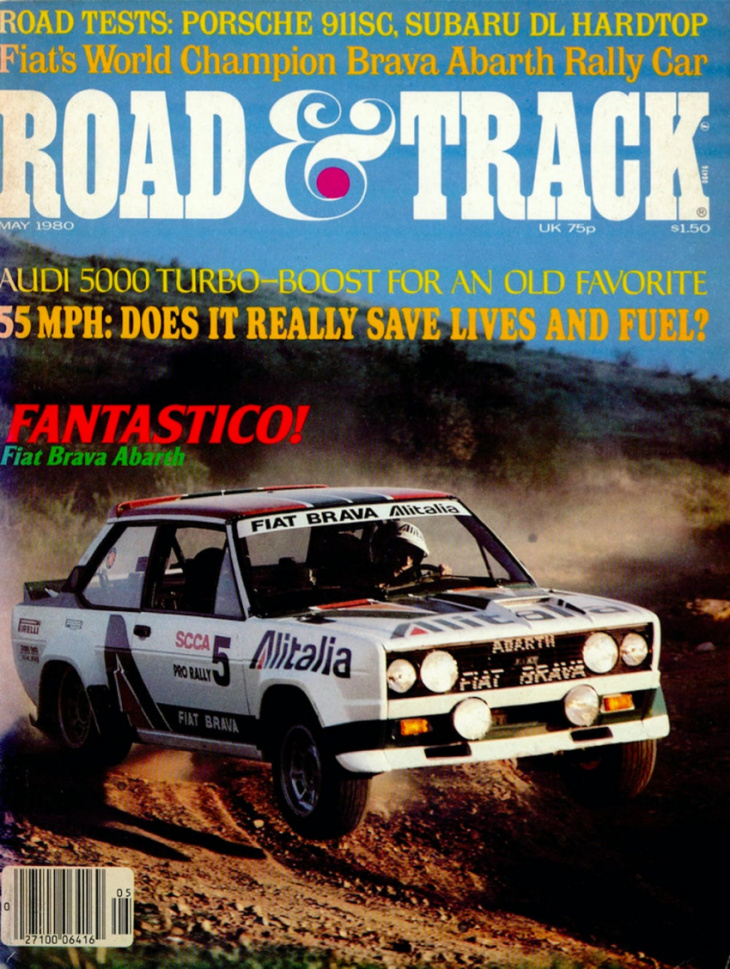
To compete on this veritable sea of variables. Fiat picked the Brava, most likely because of the numbers in which this model is sold around the world, and the impact a rally victory can have in the showrooms of many of these countries. Like all competition cars, the Brava Abarths are different than their production counterparts, but probably more so than in most of the past competition cars we’ve tested, because of some very basic changes in design between the standard and modified cars. Then again, the rally cars are also production cars in a sense. Fiat had to build 400 such models to qualify for Group 4. because international rally regulations don’t allow one-off or very limited series cars. The English term “purpose-built” fits the Brava Abarth perfectly. What does it share with the standard Brava? Basic shape, driveline layout, the engine, five speeds in the gearbox, MacPherson-strut front suspension, the name . . . and that’s about it.
First introduced at the 1976 Monte Carlo rally, the Bravas are built—as opposed to modified or rebuilt—in the Turin. Italy factory of recently deceased Carlo Abarth. An Austrian-born, onetime Porsche engineer who moved to Turin in 1947, Abarth was renowned for the manner in which he could modify Fiats— from the little 600 on up—into cars with more horsepower and handling prowess than was ever imagined by their creators. Bought by Fiat in 1971, the firm produces speed equipment, high-performance engines and many of Fiat’s and Lancia’s competition cars.
The car we tested was one of the pair campaigned in the U.S. during 1979 by Fiat Motors of North America, hence the use of Brava in our story instead of 131. Actually the cars are interchangeable, different only in the details that separate rally cars built for various types of rallies and road surfaces.
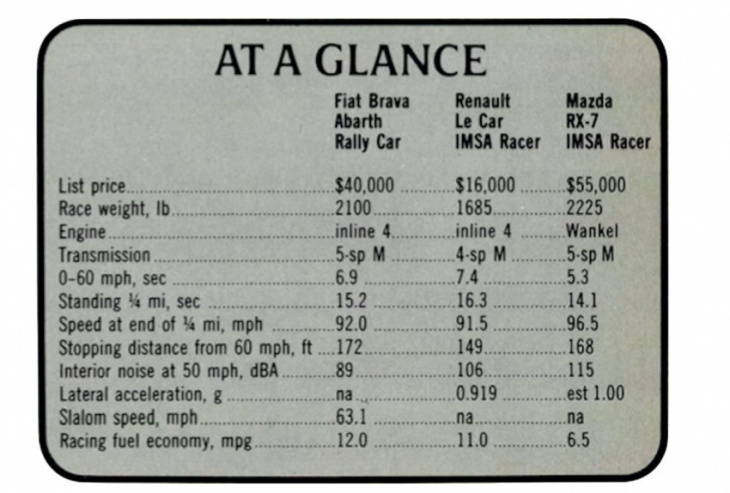
The rally Brava’s steel unit body is appropriately reinforced for the rough treatment it will suffer. The chassis is further strengthened by engine compartment braces and a full roll cage, then clothed with fiberglass fenders, hood and rear deck lid. The doors are skinned with aluminum, but keep their stock inner panels. All the windows but the windshield are Plexiglas. This lightening is done because the stock Brava is a heavy car from which to build a rally machine. There is a lighter version for paved-road rallies, when all the extra reinforcing isn’t as critical. The other obvious external changes are the fender flares, a front air dam and a spoiler on the trailing edge of the roof to route air to the deck lid spoiler. The air dam, by the way, is so prone to destruction that Fiat painted the name of its 1979 sponsor, Alitalia, on the body behind it so that when the spoiler inevitably disintegrated the airline still got its due. Under the fiberglass trunk lid are the 4.0- gal. oil tank for the dry-sump system, a pair of small batteries, two fuel pumps, fuel filters and the 15.5-gal. fuel cell with a wide-mouth. quick-release filler.
Like the production car, the Abarth rally version has Fiat’s dual-overhead-cam four with a cast iron block, but adding an aluminum head with four valves per cylinder, dry-sump lubrication, an 11.0; 1 compression ratio and all the usual engine work needed to produce a competition engine. After trading the Brava’s single carburetor for Kugelfischer fuel injection, the 1995-cc rally engine produces 230 DIN bhp (about 220 SAE net bhp) at 7500 rpm and 166 lb-ft of torque at 5750 rpm versus 80 SAE net bhp at 5000 rpm and 100 lb-ft of torque at 3000 for the U.S. production model. In rally form the engine does not have the ragged-edge tune of a road-race powerplant, but a more docile nature with a comfortable-if-Iopey idle and usable torque from 2000 rpm up to its redline of 7500 rpm. The engine is protected underneath by a sturdy skidplate.

While the racing gearbox has five speeds like the standard transmission, the two have little else in common. The gears for the Abarth car are straight cut, with closely spaced ratios and a shift pattern that proves its racing pedigree. First gear is in the lower left position and the next four cogs come in the usual H- pattern to the right of this; reverse is above 1st gear. There are two homologated gearboxes to allow for two sets of ratios, and five possible ratios for the ZF limited-slip rear end.
The rally Brava’s MacPherson-strut front suspension is of the same basic configuration as the production car’s, but with different pieces, more adjustability and, quite important in rallying, the struts can be replaced in 15-20 minutes.

The Brava Abarth’s trailing- arm rear suspension has very wide-base arms and a rear link for quick toe-in/toe-out adjustment.
Road & Track
For the rear suspension, Fiat considered a solid axle, De Dion and two independent designs, but opted for one of the IRS systems. Perhaps no area of the Fiat more aptly shows its purpose-built nature than this suspension. As desirable as an independent layout may be in a road-racing car, it means still more in a rally machine where its flexibility and long wheel travel are even more important as the driver spends so much time trying to get power down despite potholes and a gravel surface. Wanting to minimize camber changes, Fiat developed an independent rear suspension with very wide-base trailing arms, the forward arm of the triangle mounted 5.0 in. behind the door and the transverse arm attached to the differential housing. A link behind the transverse arm makes adjustment of toe-in/toe-out a quick, simple matter. All this is sprung and damped by Chapman struts (all Brava struts are made by Bilstein) which are as easily changed as the fronts.
Brakes are ventilated discs all around, 10.8-in. diameter in front and 10.0 in. at the back. The rear discs have dual calipers, one a part of the basic ATE hydraulic brake system and the other a Brembo caliper that is operated by the hydraulic, non-ratchet handbrake, an important item in rallying. Steering is by rack and pinion and needs 2.9 turns to get through a 33.8-ft turning circle. That’s about the same combination of turns and turning circle we’d expect from a competition car or perhaps a luxury sedan with power steering, but remember the rally driver has no assist and must continue to work that sort of effort for special stages strung out over a 2-4 day event. Although there is a variety of wheels and tires for the Fiat to suit everything from slimy mud to smooth pavement, the set on our test car was 205/60VR-15 Pirelli P7s on 15 x 7-in. Cromodora magnesium wheels.
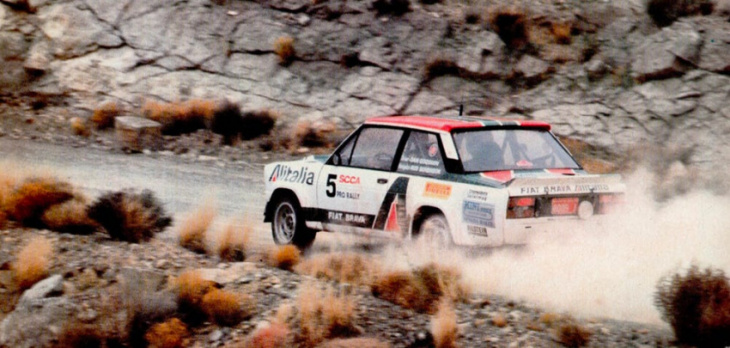
Being a roll cage-trussed car, the Brava Abarth gets low points for ingress and egress, but no doubt the driver and co-driver have no complaints about climbing over a brace before dropping into the deep seats. The bucket’s high sides will hold you firmly against lateral movements, while a set of competition seat-, shoulder- and crotch straps provide the final entrapment. The rear seat is replaced by a large piece of foam rubber with two deep holes to hold the crew’s helmets when they’re not being used. The area looks like a 2-hole bench in an outhouse.
The co-driver faces a pair of Halda Tripmasters for measuring distances and two Fleuer analog stopwatches for checking time. While the driver’s side of the dashboard has an alternator light, his partner’s has the ammeter, along with 12 Bosch relays and a row of 16 fuses. It must be hell trying to change those little devils while the car is bouncing along. Affixed to the rollbar behind the windshield top is a flexible-neck Lucas lamp, while beneath the co-driver’s legs the all-important lug wrench is held down with a rubber strap.
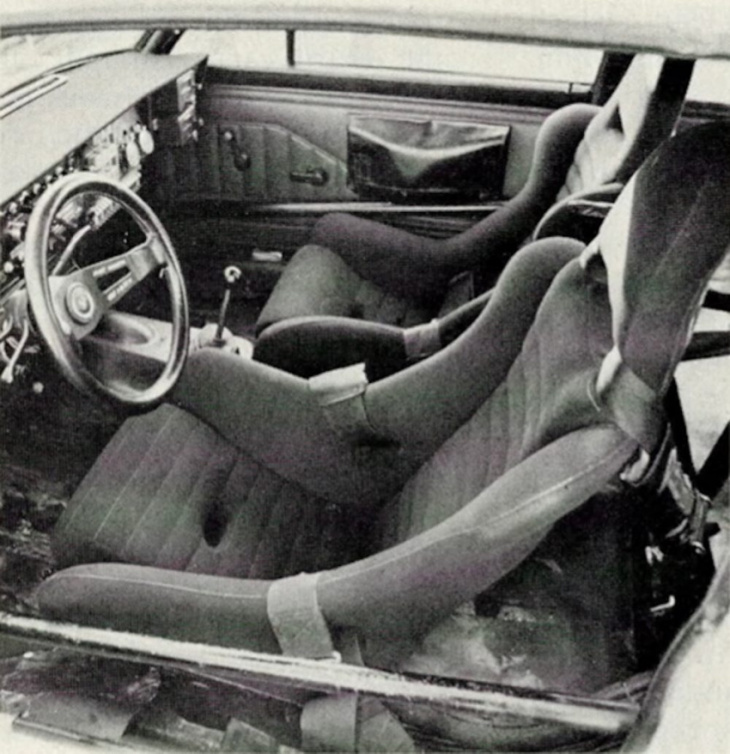
Although he has precious little time to read them, the driver has ahead of him a tachometer, and gauges for oil pressure, fuel pressure, oil temperature, coolant temperature and fuel level. In the middle of the dash is a bank of switches for the various fog and driving lights, the fuel pumps, and fans for the interior and the radiator. You need to pull out the choke cable when the engine is cold, pull the ignition switch, hold down the spark retard button with your right thumb, then push the starter button with your index finger. When the engine fires, release the retard button, get the revs to 2000 to keep the electrical system charging and then release the choke. Giving the throttle an occasional shot to keep the plugs clean, get the temperatures up and you’re ready.
Like any crashbox, the Fiat’s 5-speed doesn’t reward subtlety, so in with the clutch, pop the lever into 1st gear and with just a bit of clutch slipping you’re underway. While the engine pulls from 2000 rpm. the real power is between 5000 and 7500 rpm (our test rev limit, though 8000 is the rallying redline) and the short gaps between gear ratios will almost always keep you in the power band. Get to the redline in one gear and it’s just a short, quick stab into the next, being alert for lever kickback that will turn an ungloved hand into a mass of numbed Jell-O in a very short period. A quick row through that excellent gearbox will get you to 60 mph in about 6.9 seconds and through the quarter-mile in 15.6 sec at a speed of 92.0 mph. That’s with a 4.88:1 rear end which will top the car at about 113 mph. If you care to come down a gear, the heel-and-toeing is simple and double-clutching recommended, then just pop it back from cog to cog.
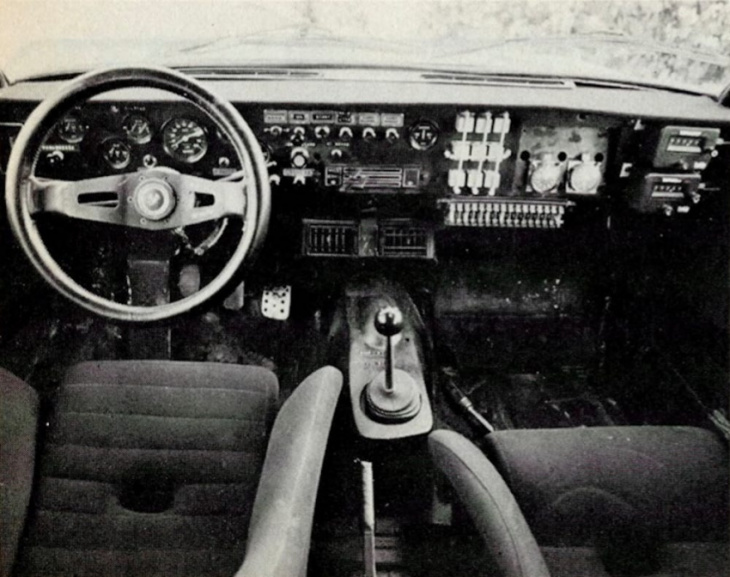
As you can imagine, all this happens in a noisy environment, the Fiat’s ranging from 71 dBA at idle to 104 dBA at the redline in 1st gear, but settling down to 90-97 dBA between 50 and 90 mph. That’s a far cry from Rolls-Royce numbers, which would range from 20-50 decibels lower, but is also well below the painful sounds we recorded in the RX-7 track test in November 1979 when we measured 125 dBA at 90 mph. Because of the closeness of the gears and the sometimes tight nature of rally roads, the sounds in the Fiat aren’t so much loud as frantic, the revs seemingly always on the climb or decline, accompanied by a great deal of gear whine. Music is in the ears of the listener, provided he manages to retain his hearing at all.
Ride and handling of the Brava Abarth are different than we would normally find in circuit competition cars, the suspension being relatively compliant and with above average wheel travel. When you first turn into a corner, the car actually seems to lean a bit and for a split second almost feels tippy. You realize, of course, that’s only the initial feeling (more imagined than real) and the suspension quickly takes a nice set. There is initial understeer, but that can be dispensed with immediately with the accelerator, and just how much oversteer you have through the corner is entirely dependent on how deeply you care to get into the throttle. Go through in a good old broad slide if you care to, and the Pirelli P7s seem just as willing as the car to do your bidding. Driving on dirt or mud produces about the same reaction for every action, but it all just happens faster. The Brava Abarth slipped through our slalom at the impressive speed of 63.1 mph—right up with the best we’ve tested—and did it with tremendous style and grace, graduating to oversteer right at the limit. Unfortunately, a series of winter storms kept the rally car off the skidpad, so we have no figures for that test. While the rally car’s ride was firmer than any production car, it was better than some modified street sports cars and well below the vision- blurring hardness of a track race car.
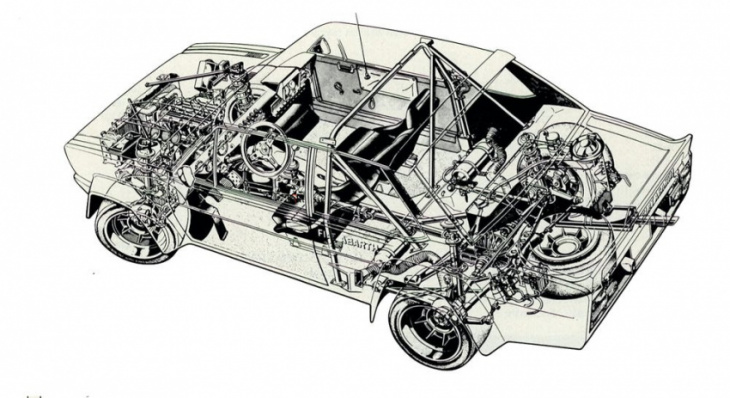
Although the Fiat Brava Abarth Rallv has the same layout as the street Brava, it is substantially different, weighing less, having independent rear suspension and a long list of detail changes.
Road & Track
The brake pedal requires a fairly high effort and the distances didn’t set any records with us (172 ft from 60 mph and 282 ft from 80 mph). Flowever, the length of the stops was respectable and the brakes didn’t even hint of fade despite a minimal cool-down time. We suspect that on a wooded special stage at night that brake dependability factor counts above most everything else they could provide.
The term purpose-built keeps creeping back into the vocabulary when you’re around the Brava Abarth Rally. Nonetheless, we were able to drive the car on the street with little problem other than the attention the paint scheme and numbers drew and the problem we had keeping the noise to a minimum. We’ve had normal production cars with poor emissions controls that were a bigger problem in traffic than the Brava Abarth. Still, the car’s purpose is rallying and you can see that not only in its construction, but also its detailing. There are, for instance, little shock absorbers to take the jolt out of the steering rack, the differential and the gearbox, easing the strain on driver and car. And it’s fair to say the Brava Abarth has lived up to its purpose, since it won the World Rally Championship in 1977 and 1978 and earlier this year finished 1st, 3rd and 7th in the Monte Carlo rally. Even when you have horses for courses, the thoroughbreds tend to stand out in a crowd.
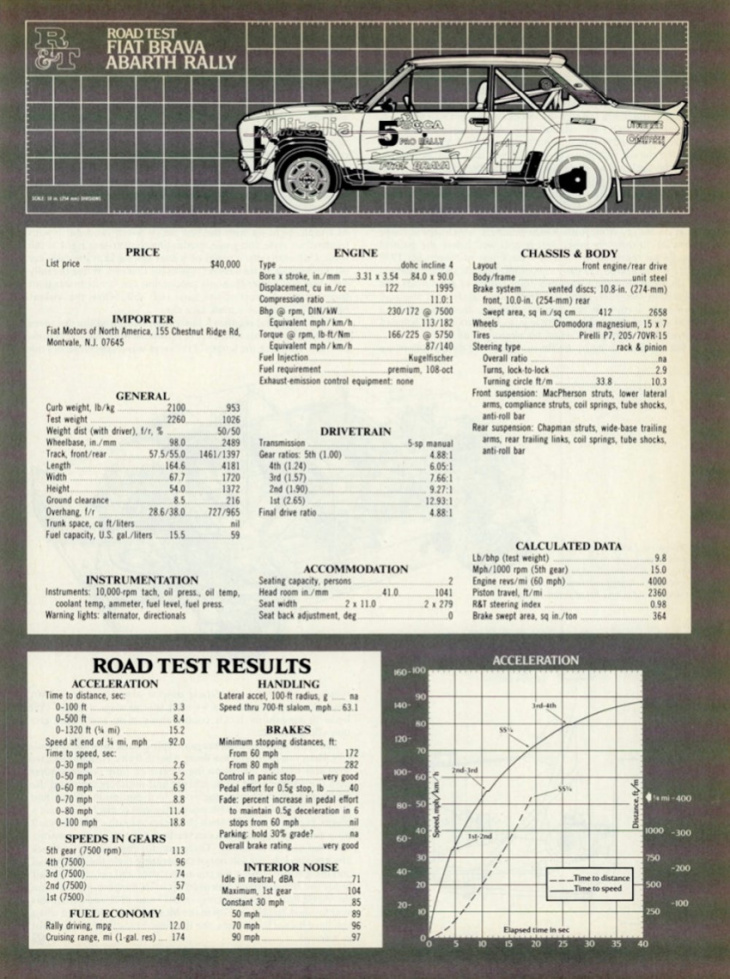
Keyword: The Fiat Brava Abarth Is a Frantic Rally Partner
